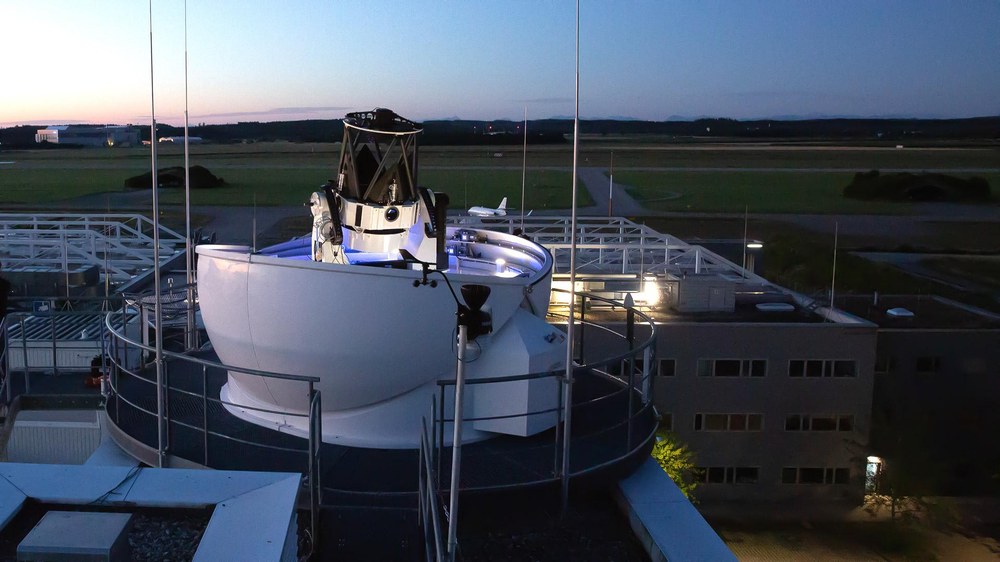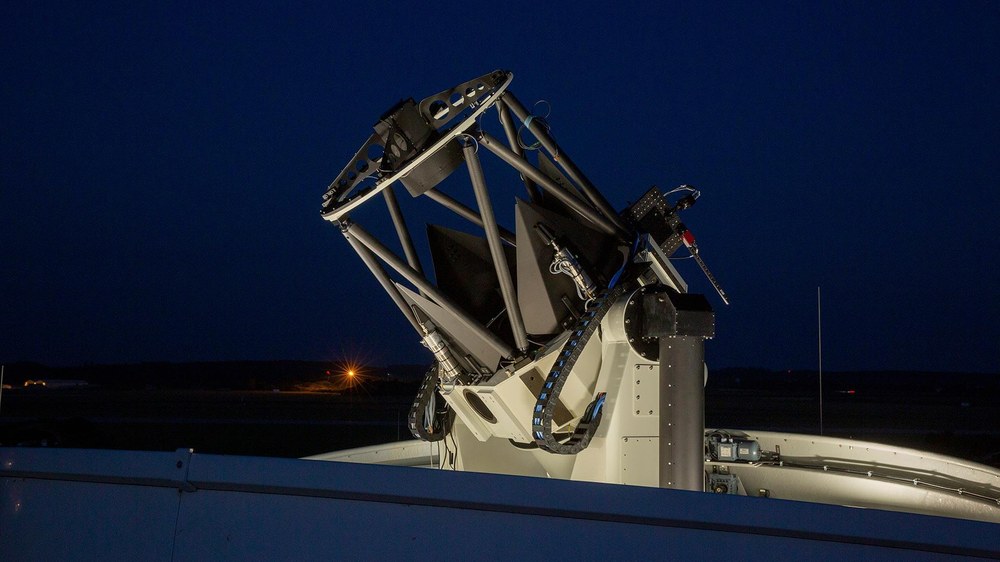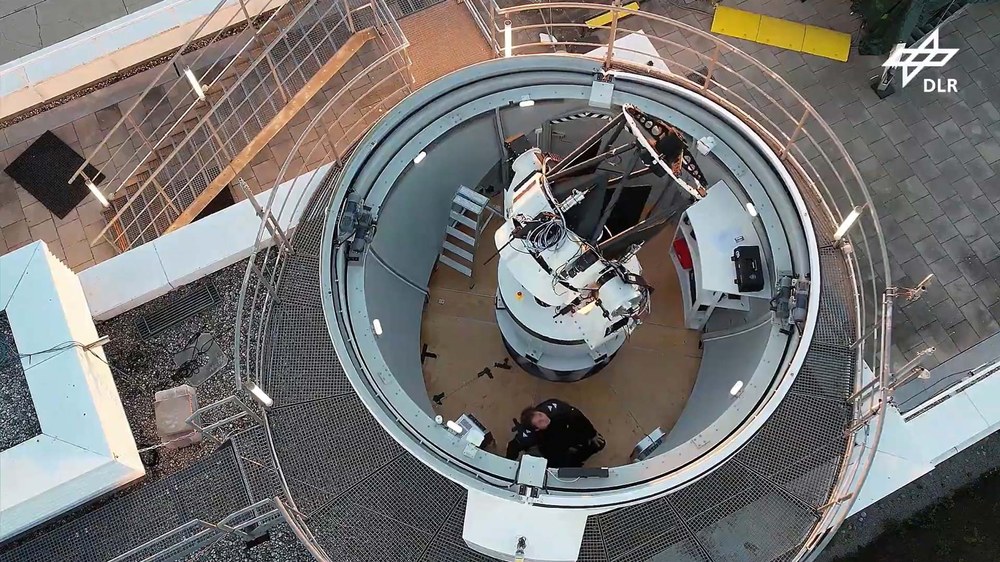New optical ground station inaugurated at DLR's site in Oberpfaffenhofen



- In future, laser communication will be an indispensable tool for fast and secure data links via satellite.
- The diverse possibilities of optical free-space communication can now be tested and further developed with a newly expanded ground station at the DLR site in Oberpfaffenhofen.
- The technology enables data rates in the terabit range, the use of quantum communication technologies and high-precision satellite navigation systems.
- Focus: Space, communications, navigation, Earth observation
Satellites are increasingly becoming network nodes of the internet. Terrestrial nodes are integrated via fibre optic networks, and satellites can only keep up with current developments on the ground if they are also optically networked. European Commission programmes such as the 'Secure Connectivity Initiative' depend on this technology, as do many commercial networks such as Starlink or Oneweb, which aim to deploy similar developments on their next generation of satellites. At the core of this technology are optical satellite links, which have been designed, developed and tested at the Institute of Communications and Navigation of the German Aerospace Center (Deutsches Zentrum für Luft- und Raumfahrt; DLR) for more than 20 years. In addition to communications networks, optical links are also being considered for the deployment of quantum secure communications. This would improve the security of the internet and of next generation of satellite navigation systems in the future. DLR has operated experimental ground stations to advance these technologies for many years. On 12 October 2022, a new, more powerful ground station was inaugurated at DLR's Oberpfaffenhofen site.
"In the future, it will become increasingly important to efficiently network satellites with each other and to exchange data securely and efficiently with the ground," says Anke Kaysser-Pyzalla, Chair of the DLR Executive Board. "This is driven by the ever-increasing data volumes involved in communications, navigation and Earth observation activities, as well as by the increasingly scarcity of radiocommunications licences. Free-space optical communication offers a promising alternative here. The newly expanded ground station in Oberpfaffenhofen will make it possible to test and further develop its numerous applications. Satellite-based quantum communication solutions will be particularly important for users that need to exchange sensitive data securely, such as those involved in critical space-based and Earth-bound infrastructure." The centrepiece of the new optical ground station is a new telescope with a diameter of 80 centimetres. The telescope is a Coudé focus telescope, in which the light collected by the telescope is guided via mirrors directly into a laboratory below. This makes it possible to conduct new experiments that could not be carried out before.

Optical Ground Station Oberpfaffenhofen OGSOP
Your consent to the storage of data ('cookies') is required for the playback of this video on Youtube.com. You can view and change your current data storage settings at any time under privacy.
Data transmission at terabit speed
The atmosphere represents a special challenge for optical connections between satellites and receiving stations on the ground, such as those used to connect communication satellites to the internet or to transmit data from Earth observation satellites to their data processing centres. Temperature fluctuations in the atmosphere lead to distortion of the optical satellite signals, which can cause transmission errors.
The new ground station makes it possible to investigate these phenomena more precisely than before in order to develop methods for error-free transmission even under difficult conditions. With this in mind, the work at the DLR Institute of Communications and Navigation aims to both improve signal reception on the ground and to 'pre-distort' the ground station's transmission signals in such a way that they reach the satellite as undisturbed as possible. In ground-based tests, the Institute was able to achieve a transmission rate of 1.72 terabits per second in 2016 and a transmission rate of 13.2 terabits per second in 2017. This data rate would be sufficient to supply the entirety of Western Europe with a fast internet connection. With the new ground station, such tests will now also be carried out with satellites.
Quantum keys from space
The ability to precisely correct satellite signals is also a fundamental prerequisite for efficiently distributing quantum keys from space. The DLR Institute of Communications and Navigation has carried out successful preliminary work here, and, together with the Ludwig Maximilian University of Munich (LMU), conducted successful transmission tests from an aircraft to the ground in 2013. Quantum keys will be used in the future to secure encrypted terrestrial transmission in such a way that they can withstand attacks by quantum computers. "Such proven communication security is essential, especially for users such as government agencies and authorities, banks, and insurance and industrial companies," says Susann Groß, Head of DLR's Programme Space R&D.
More precise navigation with optical satellite links
Satellite navigation systems such as the European Galileo and the American GPS are already indispensable infrastructures in everyday life and for our economies. The satellites in these constellations transmit precise time signals. If the receiver receives this information from at least four satellites and the satellites’ orbits are precisely known, the clocks can be correctly synchronised, and the receiver can use it to determine their exact position. Today, synchronising the time signals from the satellites and determining the satellites' orbits require a complex process based on measurements from a large number of sensor stations on the ground. At DLR, a new approach known as 'Kepler' has been developed, which uses optical links between navigation satellites. These optical links are used to directly synchronise the satellites and to precisely determine their orbits using only two ground stations. This not only leads to a significant simplification of the system, but also to a greatly improved accuracy.
"The highly precise location data provided by the Kepler approach has significant potential for use in the automation of traffic on the ground," says Anke Pagels-Kerp, DLR Divisional Board Member for Space. The system would also be resilient to disturbances that are deliberately brought about today in regions of war and crisis, for example. In this context, the new ground station will provide valuable contributions to the validation of DLR concepts.
Technology transfer
The DLR Institute of Communications and Navigation is one of the world's leading research facilities for the development of free-space optical communication links. Companies located close to the Institute, such as TESAT Spacecom in Backnang and the spin-off Mynaric, have become important firms in the sector. The new ground station will help to maintain and further develop the strong position of German industry.
